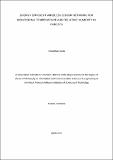| dc.description.abstract | Monitoring the forest‟s weather has been essential to living things over the years. Currently,
there is a shortage of information on real-time temporal and spatial environmental conditions
of the forest that drive forest health condition. This work focuses on the sensing of humidity
and temperature as weather data from the forest. Unlike the traditional systems used to collect
weather information, the use of wireless sensor network (WSN) gives real-time data capture
from every point of the forest. However, the WSN faces the number of challenges including
low bandwidth, low power, and short battery lifespan. Reducing the network delay and
improving the network lifetime are always big issues in the domain of WSN. To resolve these
downsides, this work proposes an Energy Efficient Scheduling using Deep Reinforcement
Learning (DRL) ( S-DRL) algorithm in WSN. S-DRL contributes three phases to
prolong network lifetime and to reduce network delay that is: Clustering phase, Duty-Cycling
phase and Routing phase. S-DRL starts with the clustering phase where it reduces the
energy consumption incurred during data aggregation. It is achieved through Zone based
Clustering (ZbC) scheme. In ZbC scheme, hybrid Particle Swarm Optimization (PSO) and
Affinity Propagation (AP) algorithms are utilized. Duty cycling is adopted in the second
phase by executing DRL algorithm. Here, the sensor node autonomously decides its sleep or
wakeup time to transmit sensed data to the head node. From which, S-DRL reduces the
energy consumption of individual sensor nodes effectually. The transmission delay is
mitigated in third (routing) phase using Ant Colony Optimization (ACO) and FireFly
Algorithm (FFA). S-DRL is modeled in the Network Simulator 3.26 (NS3) simulator. The
results conquered are valuable in provisions of upcoming metrics including network lifetime,
energy consumption, throughput and delay. From this evaluation, it is proved that E2S-DRL
reduces energy consumption, delay up to 40% and enhances throughput and network lifetime
up to 35% compared to the existing Time Division Multiple Access (cTDMA), Distributed
Random Allocation (DRA) and improved Artificial bee colony (iABC) methods. The weather
data will be stored in the database for further action. This study was conducted in the
biodiversity-rich Usambara forest reserve in Tanzania. Timely collected environmental data
will help other researchers to predict wildfire since the temperature rise can cause fire
outbreak. Finally, to evaluate the performance of the proposed system using the following
metrics namely network lifetime, energy consumption, throughput and delay. | en_US |


